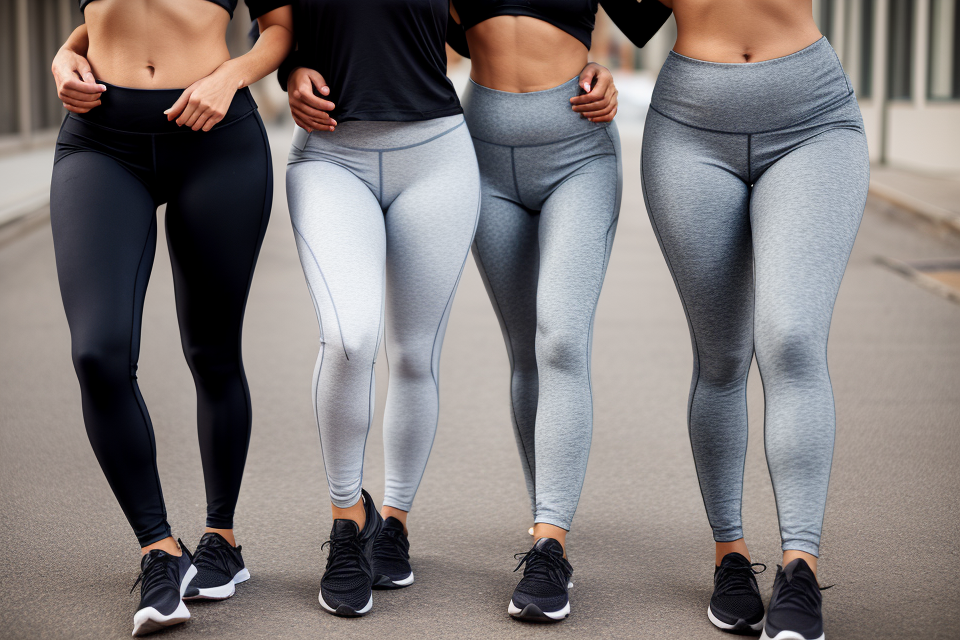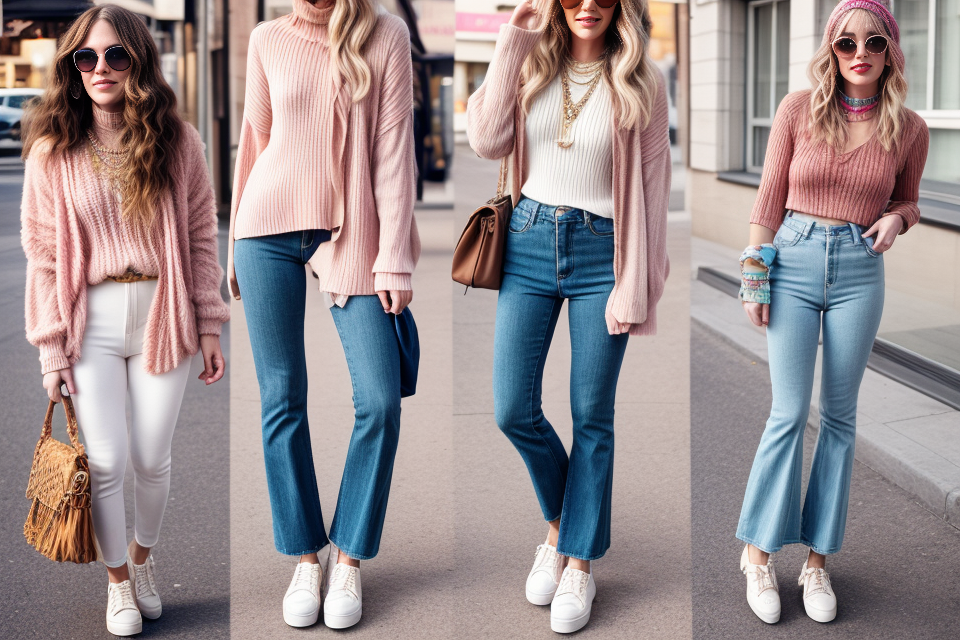When is it time to say goodbye to your beloved leggings? This is a question that many of us ask ourselves as we scramble to find the perfect pair of pants for any given occasion. While leggings are a wardrobe staple for many, there are certain times when it’s best to retire them and opt for something else. In this comprehensive guide, we’ll explore the different scenarios in which it’s time to put away your leggings and opt for something else. From formal events to professional settings, we’ll cover it all. So, whether you’re a leggings lover or simply looking to broaden your wardrobe, read on to discover when it’s time to retire your leggings.
Factors Affecting the Lifespan of Leggings
Material and Quality
The material and quality of leggings play a significant role in determining their lifespan. Different materials have varying degrees of durability, and high-quality construction can also impact how long leggings last. Here’s a closer look at the importance of material and quality when it comes to leggings.
- Comparison of different materials: When it comes to the material used in leggings, there are several options available. Cotton leggings are a popular choice, but they may not be as durable as other materials. Spandex leggings, on the other hand, are known for their stretch and flexibility, but they may not be as comfortable as cotton leggings. Polyester leggings are a good option for those who want a durable and comfortable fabric, but they may not be as breathable as cotton or spandex.
- Durability of materials: The durability of a legging’s material is also an important factor to consider. Cotton leggings may fade or wear down over time, while spandex leggings may lose their elasticity. Polyester leggings are generally more durable, but they can still be prone to snags and tears.
- Tips for identifying high-quality leggings: To ensure that your leggings last as long as possible, it’s important to choose high-quality leggings. Look for leggings made from materials that are known for their durability, such as polyester or cotton. Additionally, check the construction of the leggings to ensure that they are made to last. Well-made leggings will often have reinforced seams or stitching, which can help prevent rips and tears.
Overall, the material and quality of leggings can have a significant impact on their lifespan. By choosing leggings made from durable materials and constructed with care, you can ensure that your leggings will last longer and perform better over time.
Frequency of Wear
- Impact of regular wear on the condition and longevity of leggings
- Frequent wear and tear can cause leggings to lose their shape, elasticity, and overall quality over time.
- Regular wear can also lead to the formation of pills, which are small balls of fibers that form on the surface of the fabric.
- Leggings that are worn every day or multiple times a week may start to show signs of wear and tear more quickly than those that are worn less frequently.
- Factors that affect wear and tear (e.g. exercise intensity, body type)
- Exercise intensity can play a role in the lifespan of leggings. High-impact activities such as running or jumping can put more stress on the fabric, causing it to wear out faster.
- Body type can also affect the lifespan of leggings. For example, people with larger bodies may experience more wear and tear on their leggings due to the added pressure on the fabric.
- Recommended guidelines for rotating and washing leggings to extend their life
- Rotating your leggings by wearing them on a different day of the week can help to reduce wear and tear.
- Washing your leggings regularly can help to keep them clean and fresh, but it’s important to follow the care instructions on the label to avoid damaging the fabric.
- Avoiding the use of harsh detergents, bleach, and fabric softeners can also help to extend the lifespan of your leggings.
Personal Preference and Style
Subjective Factors that Influence the Decision to Stop Wearing Leggings
Personal preference and style play a significant role in determining when it’s time to retire your leggings. Your individual preferences may change over time, causing you to no longer feel comfortable wearing your old leggings. For example, you may have developed a dislike for the specific style or print of your leggings, or you may have grown tired of the same old outfit combinations.
Changes in Fashion Trends and Personal Style
Another factor that may influence your decision to retire your leggings is changes in fashion trends and personal style. As new styles emerge, you may find that your old leggings no longer fit in with your current wardrobe. This could be due to changes in hemlines, colors, or fabrics that are currently popular. If you feel that your leggings are outdated and no longer align with your personal style, it may be time to retire them.
Considerations for Investing in New Leggings to Replace Old Ones
While it may be tempting to hold onto your old leggings for as long as possible, there are certain benefits to investing in new ones. New leggings can provide a fresh, updated look to your wardrobe, and they can also offer improved comfort and fit. Additionally, investing in high-quality leggings can help them last longer, reducing the need to replace them as frequently. When deciding whether to retire your leggings, consider whether investing in new ones will improve your overall style and comfort.
Signs That It’s Time to Stop Wearing Your Leggings
Visible Wear and Tear
When it comes to determining when it’s time to retire your leggings, visible wear and tear is a clear sign that it’s time to let go. Over time, even the most high-quality leggings will start to show signs of wear and tear, which can impact their performance and safety.
Here are some common signs of wear and tear that indicate it’s time to retire your leggings:
- Holes: One of the most obvious signs of wear and tear is the presence of holes in your leggings. Whether caused by constant friction, snags, or tears, holes can compromise the integrity of your leggings and lead to discomfort, chafing, or even injury.
- Fading: Another common sign of wear and tear is fading. Whether caused by washing, drying, or exposure to sunlight, fading can make your leggings look old and discolored, which can affect your confidence in wearing them.
- Discoloration: Discoloration is another common sign of wear and tear that can make your leggings look old and worn. Whether caused by sweat, dirt, or exposure to the elements, discoloration can impact the appearance of your leggings and make them less appealing to wear.
It’s important to address safety concerns when it comes to damaged leggings. While some may argue that they can still wear their leggings despite visible wear and tear, the reality is that damaged leggings can compromise your safety and comfort. Whether causing chafing, discomfort, or even injury, damaged leggings can have a negative impact on your overall well-being.
In conclusion, visible wear and tear is a clear sign that it’s time to retire your leggings. Whether caused by holes, fading, or discoloration, damaged leggings can compromise your safety and comfort, making it essential to address these issues and invest in new leggings to ensure your ongoing well-being.
Loss of Comfort and Support
- How changes in fit and feel can indicate the need for new leggings
When leggings begin to feel tight or uncomfortable, it may be time to replace them. This is especially true if they feel loose or saggy in certain areas. Leggings that are too tight can cause discomfort and restrict movement, while those that are too loose can cause chafing and discomfort during exercise.
- Explanation of how the elasticity and support of leggings can deteriorate over time
Leggings are designed to provide support and compression during exercise, but over time, the elasticity and support of the fabric can deteriorate. This can cause the leggings to lose their shape and fit, which can lead to discomfort and decreased performance during exercise. Additionally, the fibers in the fabric can break down, which can cause the leggings to become more transparent and revealing.
- Importance of prioritizing comfort and support in activewear
Comfort and support are crucial factors to consider when choosing activewear. Leggings that are too tight or too loose can cause discomfort and distract from the benefits of exercise. Wearing comfortable and supportive leggings can improve performance and help to prevent injury. Additionally, investing in high-quality leggings that provide support and compression can help to increase the longevity of the garment.
Outdated Style
Wearing outdated clothing can be uncomfortable and even embarrassing. Leggings are a versatile piece of clothing that can be worn for various occasions, but there may come a time when they are no longer fashionable. It is essential to recognize the signs that it’s time to stop wearing your leggings to avoid looking outdated.
- Criteria for determining when leggings are no longer fashionable
There are several criteria to consider when determining if your leggings are no longer fashionable. First, look at the material and design of the leggings. If they are made of an outdated fabric or have an outdated design, it may be time to retire them. Additionally, if your leggings have holes, tears, or stains, it’s time to replace them. Finally, consider the fit of your leggings. If they are too tight or too loose, it may be time to say goodbye to them.
- The impact of personal style and trends on the decision to stop wearing leggings
Personal style and trends play a significant role in determining when it’s time to stop wearing your leggings. If your personal style has evolved, and your leggings no longer align with your current fashion preferences, it may be time to retire them. Additionally, if the trend for wearing leggings has declined, and they are no longer popular, it’s time to replace them with a more fashionable alternative.
- Tips for selecting new leggings that align with current fashion trends
If you’re looking to replace your outdated leggings, there are several tips to keep in mind when selecting new ones. First, consider the material and design of the leggings. Look for leggings made from high-quality materials and with modern designs that align with current fashion trends. Additionally, consider the fit of the leggings. They should be comfortable and fit well, without being too tight or too loose. Finally, choose leggings that are versatile and can be worn for various occasions, such as work, exercise, or a night out.
Leggings Care and Maintenance Tips
Proper Storage and Organization
Proper storage and organization of leggings are crucial in extending their lifespan. Here are some tips to help you keep your leggings in good condition:
- Store your leggings in a cool, dry place: Heat and moisture can cause damage to leggings, so it’s important to store them in a cool, dry place. Avoid storing them in direct sunlight or in areas with high humidity.
- Use a clean, dry surface to place your leggings on: Placing your leggings on a dirty or damp surface can cause stains or odors to set in. Use a clean, dry surface to store your leggings, such as a clean towel or a storage box.
- Roll your leggings instead of folding them: Folding your leggings can cause creases and wrinkles, which can lead to wear and tear over time. Instead, roll your leggings into a cylinder shape and store them in a storage box or on a shelf.
- Organize your leggings by type and color: To make it easier to find the leggings you want to wear, consider organizing them by type and color. This will also help prevent damage to your leggings by keeping them from getting tangled or bunched up.
- Use specific storage methods for different types of leggings: Some types of leggings, such as spandex or Lycra leggings, require specific storage methods to prevent stretching or damage. For example, spandex leggings should be stored flat to prevent them from stretching out of shape.
By following these tips, you can help ensure that your leggings stay in good condition for as long as possible.
Cleaning and Laundry
Cleaning and laundry are essential components of leggings care and maintenance. Leggings are a versatile wardrobe staple, but they can become worn and damaged if not properly cared for. Here are some tips for cleaning and laundering your leggings:
Importance of Proper Cleaning and Laundry Practices
Leggings are made from various materials, such as cotton, spandex, and polyester, and each material requires different care instructions. Improper cleaning and laundry practices can lead to damage, such as shrinking, stretching, or color fading.
It is essential to follow the care label instructions on your leggings to ensure they are cleaned and laundered correctly. The care label provides information on the best methods for washing, drying, and ironing your leggings.
Differences in Care Instructions for Different Materials
Different materials require different cleaning and laundry methods. Here are some tips for cleaning leggings made from different materials:
- Cotton leggings: Cotton leggings can be washed in cold water to prevent shrinking. Avoid using chlorine bleach on protein-based stains, such as blood, as it can cause them to yellow.
- Spandex leggings: Spandex leggings should be washed in cold water, as hot water can cause them to lose their shape. Avoid using fabric softener, as it can cause the spandex to lose its elasticity.
- Polyester leggings: Polyester leggings can be washed in cold or warm water, but avoid using hot water, as it can cause them to shrink. Avoid using bleach on polyester leggings, as it can cause them to yellow.
Tips for Avoiding Common Mistakes in Washing and Drying Leggings
Here are some tips for avoiding common mistakes when washing and drying leggings:
- Avoid using fabric softener, as it can cause leggings to lose their shape and become scratchy.
- Avoid washing leggings with items that have zippers, buttons, or other hardware, as they can snag the fabric.
- Avoid washing leggings in large loads, as they can become tangled with other items.
- Avoid using bleach on leggings, as it can cause them to lose their color or fade.
- Avoid using hot water when washing leggings, as it can cause them to shrink or lose their shape.
- Avoid using the dryer when washing leggings, as it can cause them to lose their shape and become scratchy. Instead, air-dry them or use a low heat setting in the dryer.
By following these tips, you can keep your leggings looking and feeling their best for as long as possible.
Repair and Replacement
Repairing and replacing leggings can be a great way to extend their lifespan and keep them in good condition. Here are some options for repairing and repurposing old leggings, as well as circumstances in which it may be more cost–effective to replace them rather than repair them.
Options for repairing and repurposing old leggings
There are several options for repairing and repurposing old leggings, including:
- Darning: This involves repairing small holes or tears in the fabric by sewing it up with a needle and thread. This can be a great way to extend the life of your leggings and prevent further damage.
- Patching: If your leggings have a hole or tear that is too large to be repaired with darning, you may need to patch it up. This involves cutting out a patch of fabric to cover the hole or tear, and sewing it onto the damaged area.
- Re-stretching: If your leggings have lost their elasticity and no longer fit well, you may be able to restore them to their original shape by washing them in hot water and stretching them out by hand.
Circumstances in which it may be more cost-effective to replace leggings rather than repair them
While repairing and repurposing old leggings can be a great way to extend their lifespan, there may be circumstances in which it is more cost-effective to replace them rather than repair them. For example:
- If the leggings are very old and have sustained multiple holes or tears, it may be more cost–effective to replace them rather than continue to repair them.
- If the leggings are no longer comfortable or fit well, it may be time to replace them rather than trying to repair them.
- If the leggings are damaged beyond repair, it may be more cost–effective to replace them rather than trying to fix them.
Recommendations for finding high-quality, affordable leggings as replacements
If you decide that it is time to replace your leggings, there are several options for finding high-quality, affordable leggings as replacements. Some recommendations include:
- Shopping at discount stores or outlet malls, where you may be able to find high-quality leggings at a lower price.
- Looking for sales or discounts at your favorite leggings brands, or signing up for email newsletters to stay informed about special offers.
- Considering lesser-known brands or online retailers, which may offer high-quality leggings at a lower price point.
By following these tips, you can keep your leggings in good condition and enjoy wearing them for years to come.
FAQs
1. How often should I wash my leggings?
It is recommended to wash your leggings after every wear. This will not only keep them fresh and clean, but it will also help to prevent any unpleasant odors from developing. Additionally, washing your leggings regularly will help to extend their lifespan by preventing damage from sweat and oils.
2. Can I wear leggings as pants?
Yes, leggings can be worn as pants. They are a versatile piece of clothing that can be dressed up or down depending on the occasion. However, it is important to note that leggings are not the same as pants and may not provide the same level of coverage or support. It is also worth considering the occasion and the dress code to ensure that you are wearing appropriate attire.
3. When is it time to retire my leggings?
There are several signs that it may be time to retire your leggings. If they are damaged, worn out, or no longer fit properly, it may be time to let them go. Additionally, if your leggings are stretched out, have holes or tears, or are faded or discolored, it may be time to replace them. Finally, if your leggings are uncomfortable or unflattering, it may be time to move on to a new pair.
4. Can I wear leggings in the summer?
Yes, leggings can be worn in the summer. They are a great option for layering under shorts or skirts, or for wearing on their own as a casual, comfortable outfit. However, it is important to choose lightweight, breathable leggings that will keep you cool and comfortable during hot weather.
5. Can I wear leggings to work?
It is generally not appropriate to wear leggings to work, especially if the workplace has a formal or professional dress code. Leggings are typically considered to be athletic wear, and are not considered to be appropriate for the office. However, there may be some exceptions depending on the workplace culture and the specific job requirements. It is always a good idea to check with your employer or coworkers to ensure that you are following the appropriate dress code.



